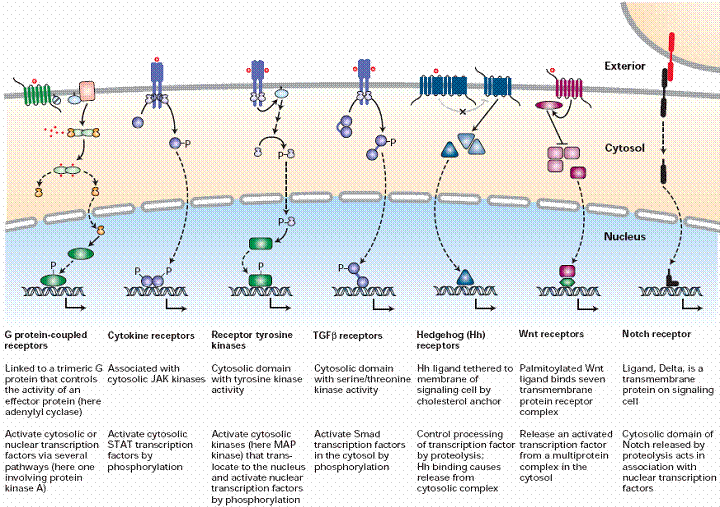Molecular and Cell Biology
Parts list

From http://classconnection.s3.amazonaws.com/0/flashcards/325000/jpg/eukaryotic_cell1305594949419.jpg
- Note that this is a idealized cell - cells come in many shapes and sizes
- You should understand what each of the labeled parts does.
Cell physiology
One way to make sense of a cell is to consider the processes it carries out routinely. Here are some of these physiological processes:
- DNA replication and repair
- Protein synthesis
- Transport
- Movement of proteins within cell
- Movement of molecules into and out of cells
- Movement of the cell itself
- Adhesion
- Metabolism
- Glycolysis
- Respiration
- Cell signaling
- Contact-mediated
- Via soluble messengers - cytokines, hormones, neurotransmitters
- Cell division
- Stages of cell cycle
- Mitosis
- Meiosis
- Cell death
- Necrosis
- Apoptosis
- Autophagy
For an overview of cellular physiology in action, see this movie
Transport
- Through cell membrane transporters

From http://biologywithmissbuchheit.com/resources/c8.7x17.transport.jpg - Endocytosis

From http://www.wpclipart.com/medical/anatomy/cells/Endocytosis_types_full_page.png - Exocytosis

From http://www.accessexcellence.org/RC/VL/GG/ecb/ecb_images/15_28_trans_Golgi_network.jpg - Within the cell via kinesin walkers

From http://www.nature.com/nrm/journal/v10/n10/images/nrm2774-i1.jpg
Adhesion

From http://csls-text3.c.u-tokyo.ac.jp/images/fig/fig11_11a.jpg
Metabolism
Most energy for cellular processes is directly powered by the conversion of ATP (adenosine triphosphate) to ADP (adenosine diphosphate). Other enrgy stores that can be used (in order of preference) to generate ATP are glucose, glycogen(in liver), fat (long-term storage), and protein (main energy source in starvation). The process of metabolism mainly revoolves around the interconversion of these eneryg sources, as well as the manufacture of essential orgainc compounds from basic biochemiclal substrates.

From http://www2.estrellamountain.edu/faculty/farabee/biobk/energpath1.gif

From http://img.sparknotes.com/figures/1/18b9012870c85fba3a8046a767b52ddf/anaerobicaerobic.gif
- Most energy-driven processes in the cell use the energy released when adenosine triphosphate (ATP) is converted into adenosine diphosphate (ADP)
- Where does ATP come from?
- From the food we eat and energy stores via respiration
- Pyruvate is generated from glucose in glycolysis
- Under anaerobic conditions, the pyruvate is converted into lactic acid
- Under aerobic conditions, the pyruvate enters into mitochondira, where it is converted to carbon dioxide and water via the citric acid cycle (Kreb’s cycle) and oxidative phosphorylation
- Aerobic respiration generates much more energy in the form of ATP than anaerobic respiration
Signaling
- A sketch of the typical process of receptor-mediated cell signaling
- Ligand binds to receptor on cell surface
- Activated receptor initiates phosphorylation cascade
- Phosphorylation cascade eventually activates transcription factor
- Activaated transciription factor moves from cytoplasm to nucleus and binds to promoter
- This triggers a sequence of events that recruite RNA polymeratse to the promoter and initiates transcription and eventually new protein synthesis
Cell-cell signaling

From http://www.accessexcellence.org/RC/VL/GG/ecb/ecb_images/16_03_signal_various.jpgCell surface receptors

From http://www.sivabio.50webs.com/csig3.gifSignal cascade

From http://www.cixip.com/Public/kindeditor/attached/image/20120928/20120928092850_34749.jpgSignal pathways interact and can be complex. Here is a greatly simplified view:

From http://upload.wikimedia.org/wikipedia/commons/f/fb/Signal_transduction_pathways.png
